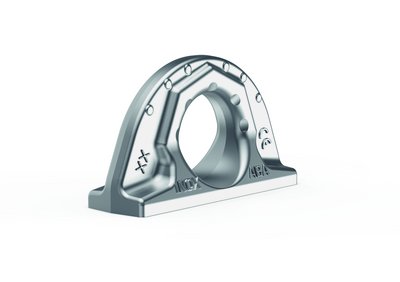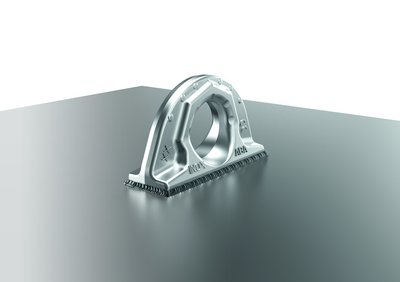Lifting in harsh conditions? – Do it safely with INOX-ABA!
RUD expands its tried-and-tested lifting point range with a stainless steel variant.
Simply welding self-made padeyes onto heavy containers, equipment and machinery - and then expecting these eyes to provide safe lifting: this questionable ‘classic’ method of lifting technology is not uncommon, even in harsh environments. On boilers and tanks in chemical or food processing plants, on machinery in the paper and pulp industry, but also on trucks and cruise liners, self-made padeyes are still often found that are relatively simple to produce and at best roughly matched to the component weight. Most of them have neither a clearly defined WLL nor design factors, not to mention an official certification. Despite this, many users seem to assume that these welded-on eyes will continue to perform their function over the long term and ensure safe transport, for example when replacing industrial boilers - including resistance to repeated rotation and shock WLLs.
Corrosive environments increase self-made padeye deficits
There is no other way to put it; this is dangerous recklessness. This is because self-made padeyes offer virtually no safety, even in transport situations that are not subject to critical environmental influences. Anyone who has seen how deformed many such eyes are after even just one load movement, is unlikely to rely on the same solution again. This problem is magnified in harsh environments: where surfaces are exposed to the effects of weather, salt water, high temperatures or dust - sometimes over many years - welded self-made padeyes are also subject to massive corrosion and ultimately become an incalculable safety risk. Using them for lifting then becomes unacceptable from an occupational health and safety and investment point of view. In addition, it is not uncommon to see flaking coatings on simple lifting points made from low-quality structural steels. In hygiene-sensitive areas such as the food industry, this is seriously problematic.
INOX-ABA lifting points made of stainless steel offer the necessary safety
The only safe and smart solution is therefore ultimately to use sturdy lifting points with a clearly defined WLL, sufficient design factors and official certifications for critical areas of application instead of simple self-made padeyes. Many of the weldable lifting points currently available on the market are not corrosion-resistant, or only to a limited extent, and are therefore at best only suitable for harsh environments with restrictions. RUD has therefore added a stainless steel version (Inox) to the extremely success series of its weldable W-ABA lifting points. The INOX-ABA is resistant to pitting and surface corrosion, also withstands hot steam or seawater and does not cause any contamination from detached coatings or other falling particles. An endless circular fillet weld protects it from the penetrating rust users dread in harsh-environment lifting points. It is made from duplex steel 1.4462, an austenitic-ferritic chromium-nickel-molybdenum steel that also permits black and white joints. The lifting point can therefore not only be welded with stainless steel surfaces, but also with surfaces made of different construction steels. It is therefore fundamentally compatible with numerous designs and can be used for the large stainless steel boilers and stainless steel tanks used in food manufacturing as well as for construction steel-based line pipes in the oil and gas industry.
Advantages of all-round load-bearing lifting points available even in harsh environments
The INOX-ABA provides users with all the advantages that have made the W-ABA lifting points so successful, even in harsh environments. These include the capability for handling loads from any direction, increased WLL in the load ring plane (in some cases exceeding the officially approved load weight three times over) and four times the protection against breakage. Safety testing is also optimally supported: the internal and external wear occurrence lenses allow easy and reliable discard maturity testing, while the magnetic properties of duplex steel 1.4462 also facilitate the mandatory electromagnetic crack testing. The lifting points are available with WLLs of 0.8, 1.6 and 2.7 tons, and designed for ambient temperatures from -40°C to +350°C. They can therefore be used in most industrial harsh environment scenarios just as easily as in shipping or pipeline construction.
Options for use in personal safety
Users who want to lift heavy containers, equipment and machines and move them from A to B no longer have any excuse for taking the risk of using self-made padeyes in harsh environments. The INOX-ABA weldable stainless steel lifting point is a solution on the market that reliably withstands even critical environmental influences and continues to enable safe lifting and transporting even years later. The huge safety advantages offered by lifting points over self-made padeyes are therefore now also available where in the past, corrosion-related deficits were to be expected with almost every solution over time. This also benefits personal safety: the 1.6 ton version of the INOX-ABA is PPE-certified, which allows it to be used beyond load handling as an anchor point for fall arrest protection in harsh environments - for example on ocean-going vessels or wind turbines. The stainless steel lifting point therefore ultimately proves itself to be a genuine all-rounder for harsh environments.


